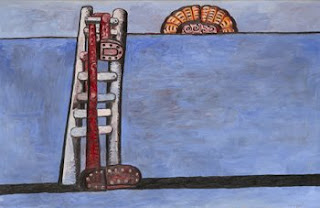
While viewing the modern art collection at the National Gallery last weekend, I stumbled upon a small but wonderful exhibition in the Tower in the East Wing.
Guston hailed from Montreal and painted during the Depression era. His style changed dramatically over the years as he began as an abstract expressionist painter working alongside his school friend, Jackson Pollock, and receiving accolades and critical success in the art world; however, in the end his painting became so esoteric that he was shunned by many of his colleagues as his painting were deemed nonsensical and not relevant.
Guston hailed from Montreal and painted during the Depression era. His style changed dramatically over the years as he began as an abstract expressionist painter working alongside his school friend, Jackson Pollock, and receiving accolades and critical success in the art world; however, in the end his painting became so esoteric that he was shunned by many of his colleagues as his painting were deemed nonsensical and not relevant.
I've included examples of his early works and his works later in his career. The first work, "To Felleni" was completed in 1958 and the second "Ladder" was completed in 1978. The differences between the two are dramatic and one can see how far he strayed from the acceptable style of the times. He was a rebellious and pioneer. Now his later works are celebrated in today's art world for their originality and message.
The exhibit only skims the surface as Guston also painted political pieces (i.e. "Rug") as well as some of his works that were inspired by the comic strips of the day.
While at the exhibit be sure to view the 6 minute video footage where you can see the late Guston at his studio as he explains some of his most famous works.
Guston in the Tower at the National Gallery of Art February 1–September 13, 2009.
Be sure to go!





No comments:
Post a Comment